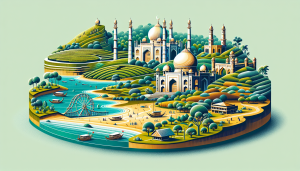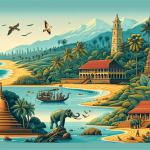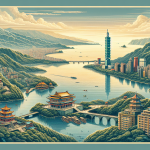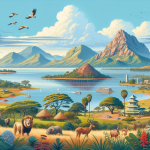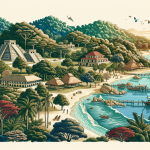Exploring the Cultural and Natural Wonders of Bangladesh
Bangladesh, a South Asian country marked by lush greenery and numerous waterways, is often overlooked as a travel destination. However, this hidden gem has much to offer travelers willing to explore its depths. From its vibrant culture and rich history to its breathtaking natural landscapes, Bangladesh promises an unforgettable experience. This article will serve as your ultimate guide to understanding and exploring the wonders of Bangladesh. With a focus on SEO techniques and long-tail keywords, we’ll delve into the best places to visit, the unique cultural elements, and the practical tips for making the most of your trip to Bangladesh.
Dhaka: The Bustling Capital of Bangladesh
Dhaka, the capital city of Bangladesh, is a bustling metropolis that offers a blend of modernity and tradition. As the heart of the country, Dhaka is teeming with life, characterized by its chaotic streets, vibrant markets, and historical landmarks. One can spend days exploring the old city, where the narrow lanes lead to hidden gems like the **Ahsan Manzil**, also known as the Pink Palace, and the **Lalbagh Fort**, an incomplete Mughal fortress with a fascinating history. Beyond the historical sites, Dhaka’s modern side is equally captivating, with its upscale shopping districts, diverse culinary scene, and contemporary art galleries.
Historical Landmarks in Dhaka
**Ahsan Manzil**: This stunning pink palace, once the residence of the Nawab of Dhaka, now serves as a museum showcasing the rich history and culture of Bangladesh. Visitors can explore the opulent rooms, lush gardens, and learn about the Nawab’s role in the region’s history.
**Lalbagh Fort**: Although incomplete, the Lalbagh Fort is a testament to the architectural prowess of the Mughal Empire. The fort complex includes a mosque, the tomb of Pari Bibi, and several other structures that offer a glimpse into the past.
The Sundarbans: A UNESCO World Heritage Site
No visit to Bangladesh would be complete without experiencing the Sundarbans, the largest mangrove forest in the world and a UNESCO World Heritage Site. This unique ecosystem is home to the famous **Royal Bengal Tiger**, as well as a plethora of other wildlife, including crocodiles, deer, and various bird species. Exploring the Sundarbans typically involves a boat safari, where visitors can navigate the winding waterways, observe the diverse flora and fauna, and enjoy the tranquility of this pristine natural environment.
Wildlife Safari in the Sundarbans
**Boat Safaris**: The most popular way to explore the Sundarbans is through a boat safari. These guided tours take visitors deep into the forest, offering opportunities to spot wildlife in their natural habitat. The experienced guides are well-versed in the region’s biodiversity and can provide insightful information about the ecosystem.
**Wildlife Observation**: The Sundarbans is a haven for wildlife enthusiasts. The Royal Bengal Tiger, although elusive, is the star attraction. Apart from tigers, visitors can expect to see saltwater crocodiles, spotted deer, wild boars, and a variety of bird species, including kingfishers and herons.
Cox’s Bazar: The Longest Natural Sea Beach
For beach lovers, Cox’s Bazar is a must-visit destination. Known as the longest natural sea beach in the world, stretching over 120 kilometers, Cox’s Bazar offers stunning views of the Bay of Bengal. The beach is perfect for relaxing, sunbathing, and enjoying water activities like swimming and surfing. The nearby **Himchari National Park** and **Inani Beach** add to the allure, offering picturesque landscapes and opportunities for exploration.
Activities in Cox’s Bazar
**Beach Activities**: The main attraction in Cox’s Bazar is the beach itself. Visitors can indulge in various activities, such as swimming, sunbathing, and beach volleyball. The calm and shallow waters make it a safe and enjoyable spot for families and solo travelers alike.
**Himchari National Park**: Located just a short drive from Cox’s Bazar, Himchari National Park is a beautiful natural reserve that offers hiking trails, waterfalls, and panoramic views of the Bay of Bengal. It’s a great place for nature lovers and those looking to escape the hustle and bustle of the beach area.
Srimangal: The Tea Capital of Bangladesh
Srimangal, often referred to as the **Tea Capital of Bangladesh**, is a picturesque town located in the northeastern part of the country. Surrounded by rolling hills and lush tea gardens, Srimangal is a paradise for nature lovers and those seeking tranquility. The region is also home to various indigenous communities, adding a unique cultural dimension to the visit. One of the highlights of Srimangal is the **Lawachara National Park**, a tropical rainforest that offers a rich biodiversity and numerous hiking trails.
Exploring Srimangal
**Tea Gardens**: The tea gardens of Srimangal are a sight to behold. Visitors can take guided tours to learn about the tea cultivation process, from plucking the leaves to processing them in the factories. Many tea estates also offer tasting sessions, allowing visitors to sample different varieties of tea.
**Lawachara National Park**: This national park is a haven for wildlife enthusiasts and trekkers. The park is home to various species of flora and fauna, including the endangered hoolock gibbons. The well-marked trails make it easy for visitors to explore the dense forest and enjoy the natural beauty.
Rajshahi: The Silk City
Rajshahi, known as the **Silk City**, is located in the northwestern part of Bangladesh. The city is renowned for its silk production, mangoes, and historical sites. The **Varendra Research Museum**, one of the oldest museums in Bangladesh, offers a glimpse into the region’s rich history and cultural heritage. Rajshahi is also home to several ancient temples, mosques, and ruins, making it a fascinating destination for history buffs.
Highlights of Rajshahi
**Varendra Research Museum**: This museum is a treasure trove of artifacts, including sculptures, manuscripts, and coins. It provides valuable insights into the history and culture of the Bengal region, from ancient times to the present day.
**Puthia Temple Complex**: Located just outside Rajshahi, the Puthia Temple Complex is a must-visit for those interested in architecture and history. The complex features several Hindu temples, each with intricate carvings and unique architectural styles.
Chittagong: The Gateway to the Hill Tracts
Chittagong, the second-largest city in Bangladesh, serves as the gateway to the hill tracts region. The city itself is a bustling port and commercial hub, offering a mix of modern amenities and historical attractions. One of the highlights of Chittagong is the **Karnaphuli River**, which is ideal for boat trips and enjoying scenic views. The nearby **Patenga Beach** and **Bhatiary Lake** are also popular spots for relaxation and outdoor activities. However, the real adventure begins in the Chittagong Hill Tracts, a region known for its stunning landscapes, indigenous cultures, and trekking opportunities.
Exploring the Chittagong Hill Tracts
**Bandarban**: This district in the hill tracts is known for its picturesque landscapes, including lush hills, waterfalls, and tribal villages. Visitors can explore the **Nilgiri Hills**, **Boga Lake**, and the **Sangu River**, all of which offer breathtaking views and opportunities for trekking and adventure activities.
**Rangamati**: Another popular destination in the hill tracts, Rangamati is known for its scenic beauty and cultural diversity. The **Kaptai Lake**, one of the largest man-made lakes in Bangladesh, is a highlight of Rangamati. Visitors can enjoy boat rides, visit the tribal villages, and relax in the serene surroundings.
Practical Tips for Traveling in Bangladesh
Traveling in Bangladesh requires some planning and preparation to ensure a smooth and enjoyable trip. Here are some practical tips to help you make the most of your visit:
- **Visa and Entry Requirements**: Ensure you have the necessary visa and travel documents before entering Bangladesh. Tourist visas are generally available, but it’s advisable to check the latest requirements from the Bangladeshi embassy or consulate.
- **Best Time to Visit**: The best time to visit Bangladesh is during the winter months, from November to February, when the weather is cooler and more pleasant. Avoid traveling during the monsoon season (June to October) due to heavy rains and potential flooding.
- **Local Transportation**: Bangladesh has a well-connected network of buses, trains, and domestic flights. It’s advisable to use reputable transportation services and book tickets in advance, especially for long-distance travel.
- **Language**: Bengali (Bangla) is the official language of Bangladesh. While English is widely understood in major cities and tourist areas, learning a few basic Bengali phrases can be helpful and appreciated by the locals.
- **Cultural Etiquette**: Bangladesh is a culturally rich and diverse country with strong traditions and customs. Dress modestly, especially when visiting religious sites, and be respectful of local customs and traditions.
Bangladesh is a country waiting to be discovered. From the bustling streets of Dhaka to the serene landscapes of the Sundarbans, the longest natural sea beach at Cox’s Bazar, the tea gardens of Srimangal, the historical treasures of Rajshahi, and the adventurous hill tracts of Chittagong, there is something for every traveler. By following practical travel tips and immersing yourself in the local culture, you can experience the true essence of Bangladesh. So, pack your bags and get ready for an unforgettable journey to this fascinating country.
For more detailed information and travel tips, you can visit the official Visit Bangladesh website.
